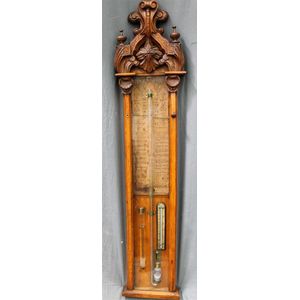
Antique Southern Hemisphere Wall Barometer by Admiral Fitzroy
Thomas Gaunt of Melbourne Admiral Fitzroy's antique wall barometer in kauri pine case, with weather indications for the southern hemisphere, 19th century, 96 cm high

19th Century English Admiral Fitzroy Barometer in Oak Case
An antique English Admiral Fitzroy's barometer in cruciform oak case with spirit thermometer and storm tube, 19th century, 105 cm high

Victorian Walnut Cased Admiral Fitzroy Barometer with Gothic Style
A Victorian walnut cased 'Admiral Fitzroy's' barometer, with 'Gothic' style case, the mercury barometer, alcohol thermometer and atmospheric tube backed by a printed card with descriptive details and scales, height 106 cm

19th Century Admiral Fitzroy Oak Case Barometer with Thermometer
An Admiral Fitzroy's oak case barometer, retailed by T.C Gaunt Melbourne, late 19th century, adapted to the Southern Hemisphere, with thermometer, 115 cm high, 32.5 cm wide, 11 cm deep

Antique Southern Hemisphere Barometer by Admiral Fitzroy, 19th Century
Admiral Fitzroy's barometer adapted to the Southern Hemisphere by R. L. J. Ellery Esq., in cedar case with original lithograph backing page, thermometer engraved T. Gaunt, maker, Melbourne, 19th century, 98 cm high

19th Century T. Gaunt & Co. 'Admiral Fitzroy' Barometer
T. Gaunt & Co. 'Admiral Fitzroy' barometer in cedar case, printed paper adapted for the southern hemisphere with rack and pinion verniers, and silvered thermometer scale. Remains of T. Gaunt label verso, 19th century, 99 cm high

Victorian Admiral Fitzroy's Barometer in Walnut Case
A Victorian walnut-cased Admiral Fitzroy's barometer, last quarter 19th century, the mercury barometer against a printed backing with Admiral Fitzroy's remarks above a storm glass and thermometer, the case with a carved crest, 128 cm high, 27 cm wide

Antique Pine Admiral Fitzroy Barometer-Thermometer
A pine cased Admiral Fitzroy's barometer, thermometer, circa 1880, with a later paper scale and thermometer marked, 'T. Gaunt, maker, Melbourne', 95 cm high

Arts & Crafts Admiral Fitzroy Barometer & Thermometer
An Arts & Crafts oak cased Admiral Fitzroy's barometer, thermometer, late 19th century, marked Lennie, 46 Princes Street Edinburgh, 105 cm high, Note, Lennie was a family of opticians and instrument makers who had a premises at this address from 1857…

Southern Hemisphere Barometer
Admiral Fitzroy's Barometer adapted to the Southern Hemisphere by R. L. J. Elerry Esq. of the Melbourne Observatory, 20th century 94.5 cm high

Antique Oak Admiral Fitzroy Barometer with Melbourne Retailer Label
Admiral Fitzroy barometer in oak case with Melbourne retailer's label (loose) for Thomas Gaunt & Co. 19th century, 103 cm high

Admiral Fitzroy's Barometer with Ellery's Indications
An Admiral Fitzroy's barometer, with Ellery's indications, 97 cm high, 22 cm wide, 5.5 cm deep

19th Century Admiral Fitzroy Wall Barometer
Admiral Fitzroy's wall barometer, oak case with brass bezel and mercury measure, 19th century, 109 cm high

Fitzroy Barometer - Service Needed
Admiral Fitzroy Royal Polytechnic Barometer oak cased barometer by Joseph Davis Co, in need of service.

Fitzroy's Barometer in Cedar Case with T. Gaunt Plaque
Admiral Fitzroy's barometer in cedar case with retailer plaque for T. Gaunt, Melbourne, 19th century, 100 cm high

Antique Fitzroy Barometer with Storm Glass and Thermometer
A General Fitzroy barometer, including storm glass and thermometer, height: 102 cm

Victorian Admiral Fitzroy Barometer with Oak Frame
A Victorian oak framed glass fronted 'Admiral Fitzroy' barometer, with mercury colum, atmosphere and temperature scales. Reg mark c. 1875. Height 104 cm

Admiral Fitzroy Barometer: Original 92cm Antique
An Admiral Fitzroy original barometer. 92 cm long, 21 cm wide

Antique Oak Cabinet Mercury Barometer, c.1880
A rare Admiral Fitzroy mercury barometer in an oak cabinet c.1880 125 cm high

Comitti Walnut Barometer, Admiral Fitzroy Design
An Admiral Fitzroy patent barometer in walnut case; by Comitti. Height 110 cm

19th Century Mahogany Admiral Fitzroy Barometer
A mahogany early 19th century 'admiral Fitzroy' style barometer.

Late 19th Century Southern Hemisphere Barometer
Australian late 19th century 'Admiral Fitzroy' barometer in cedar case, adapted to the southern hemisphere. RLJ Ellery Esquire and retailed by Thomas Gaunt, Melbourne. Length 107 cm


 Loading more...
Loading more...